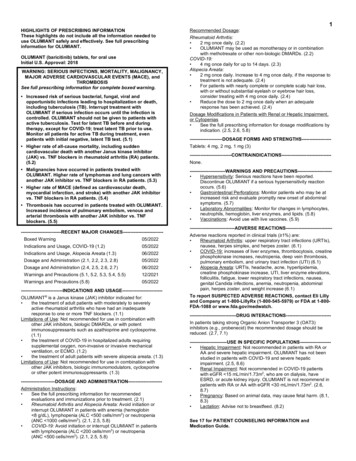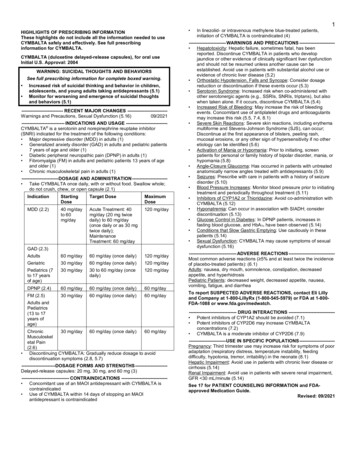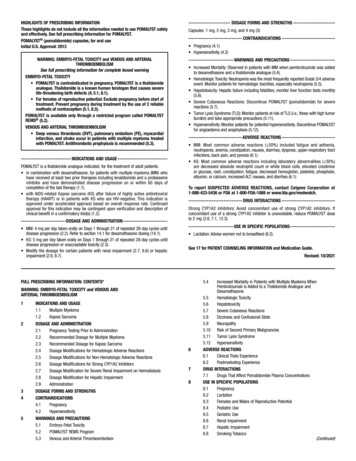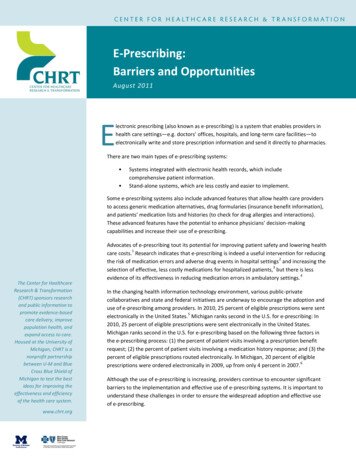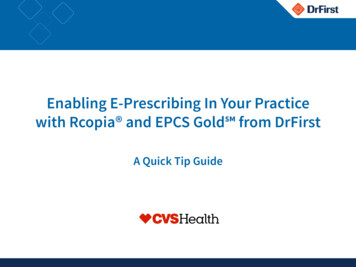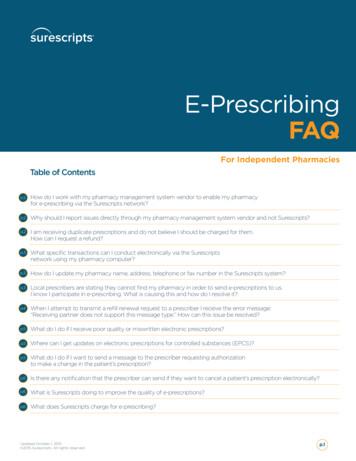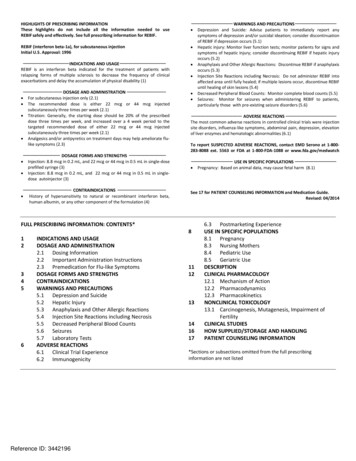
Transcription
HIGHLIGHTS OF PRESCRIBING INFORMATIONThese highlights do not include all the information needed to useREBIF safely and effectively. See full prescribing information for REBIF.REBIF (interferon beta-1a), for subcutaneous injectionInitial U.S. Approval: 1996INDICATIONS AND USAGEREBIF is an interferon beta indicated for the treatment of patients withrelapsing forms of multiple sclerosis to decrease the frequency of clinicalexacerbations and delay the accumulation of physical disability (1)DOSAGE AND ADMINISTRATION For subcutaneous injection only (2.1)The recommended dose is either 22 mcg or 44 mcg injectedsubcutaneously three times per week (2.1)Titration: Generally, the starting dose should be 20% of the prescribeddose three times per week, and increased over a 4 week period to thetargeted recommended dose of either 22 mcg or 44 mcg injectedsubcutaneously three times per week (2.1)Analgesics and/or antipyretics on treatment days may help ameliorate flulike symptoms (2.3)DOSAGE FORMS AND STRENGTHSInjection: 8.8 mcg in 0.2 mL, and 22 mcg or 44 mcg in 0.5 mL in single-doseprefilled syringe (3) Injection: 8.8 mcg in 0.2 mL, and 22 mcg or 44 mcg in 0.5 mL in singledose autoinjector (3) CONTRAINDICATIONSHistory of hypersensitivity to natural or recombinant interferon beta,human albumin, or any other component of the formulation (4) FULL PRESCRIBING INFORMATION: CONTENTS*123456INDICATIONS AND USAGEDOSAGE AND ADMINISTRATION2.1 Dosing Information2.2 Important Administration Instructions2.3 Premedication for Flu-like SymptomsDOSAGE FORMS AND STRENGTHSCONTRAINDICATIONSWARNINGS AND PRECAUTIONS5.1 Depression and Suicide5.2 Hepatic Injury5.3 Anaphylaxis and Other Allergic Reactions5.4 Injection Site Reactions including Necrosis5.5 Decreased Peripheral Blood Counts5.6 Seizures5.7 Laboratory TestsADVERSE REACTIONS6.1 Clinical Trial Experience6.2 ImmunogenicityReference ID: 3442196WARNINGS AND PRECAUTIONS Depression and Suicide: Advise patients to immediately report anysymptoms of depression and/or suicidal ideation; consider discontinuationof REBIF if depression occurs (5.1)Hepatic injury: Monitor liver function tests; monitor patients for signs andsymptoms of hepatic injury; consider discontinuing REBIF if hepatic injuryoccurs (5.2)Anaphylaxis and Other Allergic Reactions: Discontinue REBIF if anaphylaxisoccurs (5.3)Injection Site Reactions including Necrosis: Do not administer REBIF intoaffected area until fully healed; if multiple lesions occur, discontinue REBIFuntil healing of skin lesions (5.4)Decreased Peripheral Blood Counts: Monitor complete blood counts (5.5)Seizures: Monitor for seizures when administering REBIF to patients,particularly those with pre-existing seizure disorders (5.6)ADVERSE REACTIONSThe most common adverse reactions in controlled clinical trials were injectionsite disorders, influenza-like symptoms, abdominal pain, depression, elevationof liver enzymes and hematologic abnormalities (6.1)To report SUSPECTED ADVERSE REACTIONS, contact EMD Serono at 1-800283-8088 ext. 5563 or FDA at 1-800-FDA-1088 or www.fda.gov/medwatchUSE IN SPECIFIC POPULATIONSPregnancy: Based on animal data, may cause fetal harm (8.1) See 17 for PATIENT COUNSELING INFORMATION and Medication Guide.Revised: 04/201481112131416176.3 Postmarketing ExperienceUSE IN SPECIFIC POPULATIONS8.1 Pregnancy8.3 Nursing Mothers8.4 Pediatric Use8.5 Geriatric UseDESCRIPTIONCLINICAL PHARMACOLOGY12.1 Mechanism of Action12.2 Pharmacodynamics12.3 PharmacokineticsNONCLINICAL TOXICOLOGY13.1 Carcinogenesis, Mutagenesis, Impairment ofFertilityCLINICAL STUDIESHOW SUPPLIED/STORAGE AND HANDLINGPATIENT COUNSELING INFORMATION*Sections or subsections omitted from the full prescribinginformation are not listed
FULL PRESCRIBING INFORMATION1 INDICATIONS AND USAGEREBIF (interferon beta-1a) is indicated for the treatment of patients with relapsing forms ofmultiple sclerosis to decrease the frequency of clinical exacerbations and delay theaccumulation of physical disability.2 DOSAGE AND ADMINISTRATION2.1Dosing InformationThe recommended dose of REBIF is either 22 mcg or 44 mcg injected subcutaneously threetimes per week. REBIF should be administered, if possible, at the same time (preferably in thelate afternoon or evening) on the same three days (e.g., Monday, Wednesday, and Friday) atleast 48 hours apart each week.Generally, patients should be started at 20% of the prescribed dose three times per week andincreased over a 4-week period to the targeted dose, either 22 mcg three times per week (seeTable 1) or 44 mcg three times per week (see Table 2). Patients prescribed a targeted dose of22 mcg three times per week should use the prefilled syringes for titration.A Titration Pack containing 6 doses of 8.8 mcg (0.2 mL) and 6 doses of 22 mcg (0.5 mL) isavailable for use during the titration period in both REBIF prefilled syringes and REBIF Rebidoseautoinjectors.Table 1: Titration Schedule for a 22 mcg Prescribed Dose*Week of UseDoseSyringe to UseAmount of syringeWeek 1 Titration4.4 mcg8.8 mcg syringeUse half of syringeWeek 2 Titration4.4 mcg8.8 mcg syringeUse half of syringeWeek 3 Titration11 mcg22 mcg syringeUse half of syringeWeek 4 Titration11 mcg22 mcg syringeUse half of syringeWeek 5 and after22 mcg22 mcg syringe or autoinjectorUse full syringe or autoinjector*Use only prefilled syringes, not autoinjectors, to titrate to the 22 mcg Prescribed DoseReference ID: 3442196
Table 2: Titration Schedule for a 44 mcg Prescribed Dose**Week of UseDoseSyringe or Autoinjector to UseAmount of syringe or autoinjectorWeek 1 Titration8.8 mcg8.8 mcg syringe or autoinjectorUse full syringe or autoinjectorWeek 2 Titration8.8 mcg8.8 mcg syringe or autoinjectorUse full syringe or autoinjectorWeek 3 Titration22 mcg22 mcg syringe or autoinjectorUse full syringe or autoinjectorWeek 4 Titration22 mcg22 mcg syringe or autoinjectorUse full syringe or autoinjectorWeek 5 and after44 mcg44 mcg syringe or autoinjectorUse full syringe or autoinjector**Prefilled syringes or autoinjectors can be used to titrate to the 44 mcg Prescribed DoseDecreased peripheral blood counts or elevated liver function tests may necessitate dosereduction or discontinuation of REBIF administration until toxicity is resolved [see Warnings andPrecautions (5.2, 5.5) and Adverse Reactions (6)].2.2Important Administration InstructionsREBIF is intended for use under the guidance and supervision of a physician. It is recommendedthat physicians or qualified medical personnel train patients in the proper technique for selfadministering subcutaneous injections using the prefilled syringe or injection device approvedfor use with REBIF. Injection depth of the REBIF Rebidose autoinjector is fixed at 8 mm; thehealth care provider should determine the injection technique.The initial injection should be performed under the supervision of an appropriately qualifiedhealth care provider.Appropriate instruction for self-injection or injection by another person should be provided tothe patient or their caregiver, including careful review of the REBIF Medication Guide and theREBIF Rebidose autoinjector Instructions for Use that accompanies the product. Users shoulddemonstrate competency in all aspects of the injection prior to independent use. If a patient isto self-administer REBIF, the physical and cognitive ability of that patient to self-administer andproperly dispose of prefilled syringes or the REBIF Rebidose autoinjectors should be assessed.Patients with severe neurological deficits should not self-administer injections withoutassistance from a trained caregiver.Advise patients and caregivers to: visually inspect REBIF for particulate matter and discoloration prior to administration use aseptic technique when administering REBIF rotate site of injection with each dose to minimize the likelihood of severe injection sitereactions or necrosis [see Warnings and Precautions, (5.4)] use a puncture-resistant container for safe disposal of used needles, prefilled syringesand REBIF Rebidose autoinjectors do not re-use needles, syringes or REBIF Rebidose autoinjectorsReference ID: 3442196
2.3Premedication for Flu-like SymptomsConcurrent use of analgesics and/or antipyretics may help ameliorate flu-like symptomsassociated with REBIF use on treatment days.3 DOSAGE FORMS AND STRENGTHS Injection: 8.8 mcg per 0.2 mL in a graduated, single-dose REBIF prefilled syringeInjection: 22 mcg per 0.5 mL in a graduated, single-dose REBIF prefilled syringeInjection: 44 mcg per 0.5 mL in a graduated, single-dose REBIF prefilled syringeInjection: 8.8 mcg per 0.2 mL in a single-dose prefilled REBIF Rebidose autoinjectorInjection: 22 mcg per 0.5 mL in a single-dose prefilled REBIF Rebidose autoinjectorInjection: 44 mcg per 0.5 mL in a single-dose prefilled REBIF Rebidose autoinjector4 CONTRAINDICATIONSREBIF is contraindicated in patients with a history of hypersensitivity to natural or recombinantinterferon beta, human albumin, or any other component of the formulation.5WARNINGS AND PRECAUTIONS5.1Depression and SuicideREBIF (interferon beta-1a) should be used with caution in patients with depression, a conditionthat is common in people with multiple sclerosis. Depression, suicidal ideation, and suicideattempts have been reported to occur with increased frequency in patients receiving interferoncompounds, including REBIF. In addition, there have been postmarketing reports of suicide inpatients treated with REBIF. Patients should be advised to report immediately any symptoms ofdepression and/or suicidal ideation to the prescribing physician. If a patient developsdepression, cessation of treatment with REBIF should be considered.Reference ID: 3442196
5.2Hepatic InjurySevere liver injury, including some cases of hepatic failure requiring liver transplantation, hasbeen reported rarely in patients taking REBIF. Symptoms of liver dysfunction began from one tosix months following the initiation of REBIF. If jaundice or other symptoms of liver dysfunctionappear, treatment with REBIF should be discontinued immediately due to the potential for rapidprogression to liver failure.Asymptomatic elevation of hepatic transaminases (particularly SGPT) is common with interferontherapy [see Adverse Reactions (6.1)]. REBIF should be initiated with caution in patients withactive liver disease, alcohol abuse, increased serum SGPT ( 2.5 times ULN), or a history ofsignificant liver disease. Also, the potential risk of REBIF used in combination with knownhepatotoxic products should be considered prior to REBIF administration, or when adding newagents to the regimen of patients already on REBIF. Reduction of REBIF dose should beconsidered if SGPT rises above 5 times the upper limit of normal. The dose may be gradually reescalated when enzyme levels have normalized [see Warnings and Precautions (5.7); andDosage and Administration (2.1)].5.3Anaphylaxis and Other Allergic ReactionsAnaphylaxis has been reported as a rare complication of REBIF use. Other allergic reactionshave included skin rash and urticaria, and have ranged from mild to severe without a clearrelationship to dose or duration of exposure. Several allergic reactions, some severe, haveoccurred after prolonged use. Discontinue REBIF if anaphylaxis occurs.5.4Injection Site Reactions including NecrosisIn controlled clinical trials, injection site reactions occurred more frequently in REBIF-treatedpatients (92% in the 44 mcg group and 89% in the 22 mcg group) than in placebo-treatedpatients (39%) and at a higher frequency in REBIF treated patients (83%) than in AVONEXtreated patients (28%). Injection site necrosis also occurred more frequently in REBIF-treatedpatients (3% in the 44 mcg group and 1% in the 22 mcg group) than in placebo-treated patients(0) during the two years of therapy. All events resolved with conservative management.Injection site reactions including injection site pain, erythema, edema, cellulitis, abscess, andnecrosis have been reported in the postmarketing setting. Some occurred more than 2 yearsafter initiation of REBIF. Necrosis occurred at single and at multiple injection sites. Some casesof injection site necrosis required treatment with intravenous antibiotics and surgicalintervention (debridement and skin grafting).Patient understanding and use of aseptic self-injection techniques and procedures should beperiodically evaluated, particularly if injection site necrosis has occurred. Patients should beadvised of the importance of rotating sites of injection with each dose and not reusing syringes.Patients should be advised against injecting an area which is inflamed, edematous,erythematous, ecchymotic, or has any other signs of infection. These signs should be reportedto a healthcare professional immediately.Reference ID: 3442196
5.5Decreased Peripheral Blood CountsDecreased peripheral blood counts in all cell lines, including pancytopenia, have been reportedin REBIF-treated patients. In controlled clinical trials, leukopenia occurred at a higher frequencyin REBIF-treated patients (36% in 44 mcg group and 28% in 22 mcg group) than in placebotreated patients (14%) and at a higher frequency in REBIF-treated patients (6%) compared to theAVONEX-treated patients ( 1%). Thrombocytopenia and anemia occurred more frequently in 44mcg REBIF-treated patients (8% and 5%, respectively) than in placebo-treated patients (2% and3%, respectively). In a pooled analysis of 7 placebo controlled trials with REBIF doses of 22 mcgor 44 mcg, the rate of pancytopenia (in subjects with normal baseline values who developedlaboratory values less than the lower limit of normal for all 3 hematology parameterssimultaneously) was higher in the total REBIF group (5.5 per 1000 subject-year) than in theplacebo group (1.2 per 1000 subject-year). Patients should be monitored for symptoms or signsof decreased blood counts. Monitoring of complete blood and differential white blood cellcounts is also recommended [see Dosage and Administration (2.1) and Warnings andPrecautions (5.7)].5.6SeizuresCaution should be exercised when administering REBIF to patients with pre-existing seizuredisorders. Seizures have been temporally associated with the use of beta interferons, includingREBIF, in clinical trials and in postmarketing reports.5.7Laboratory TestsIn addition to those laboratory tests normally required for monitoring patients with multiplesclerosis, blood cell counts and liver function tests are recommended at regular intervals (1, 3,and 6 months) following introduction of REBIF therapy and then periodically thereafter in theabsence of clinical symptoms. Patients with myelosuppression may require more intensivemonitoring of complete blood cell counts, with differential and platelet counts [see Dosage andAdministration (2.1) and Warnings and Precautions (5.5)]. New or worsening thyroidabnormalities have developed in some patients treated with REBIF. Thyroid function tests arerecommended every 6 months in patients with a history of thyroid dysfunction or as clinicallyindicated.6 ADVERSE REACTIONSThe following adverse reactions are discussed in more detail in the Warnings and Precautionssection of the label: Reference ID: 3442196Depression and Suicide [see Warnings and Precautions (5.1)]Hepatic Injury [see Warnings and Precautions (5.2)]Anaphylaxis and Other Allergic Reactions [see Warnings and Precautions (5.3 )]Injection Site Reactions including Necrosis [see Warnings and Precautions (5.4)]Decreased Peripheral Blood Counts [see Warnings and Precautions (5.5 )]Seizures [see Warnings and Precautions (5.6)]Laboratory Tests [see Warnings and Precautions (5.7)]
6.1Clinical Trial ExperienceBecause clinical trials are conducted under widely varying conditions, adverse reaction ratesobserved in the clinical trials of REBIF cannot be directly compared to rates in the clinical trials ofother drugs and may not reflect the rates observed in practice.A total of 712 patients with relapsing-remitting multiple sclerosis (RRMS) in two controlledclinical trials took REBIF (22 mcg or 44 mcg given three times per week) [see Clinical Studies(14)]. Ages ranged from 18 to 55 years. Nearly three-fourths of the patients were female, andmore than 90% were Caucasian, largely reflecting the general demographics of the population ofpatients with multiple sclerosis.The most commonly reported adverse reactions were injection site disorders, influenza-likesymptoms (headache, fatigue, fever, rigors, chest pain, back pain, myalgia), abdominal pain,depression, elevation of liver enzymes and hematologic abnormalities. The most frequentlyreported adverse reactions resulting in clinical intervention (e.g., discontinuation of REBIF,adjustment in dosage, or the need for concomitant medication to treat an adverse reactionwere injection site disorders, influenza-like symptoms, depression, and elevation of liverenzymes [see Warnings and Precautions (5)].Study 1 was a 2-year placebo-controlled study in RRMS patients treated with REBIF 22 mcg(n 189), 44 mcg (n 184), or placebo (n 187). Table 4 enumerates adverse reactions andlaboratory abnormalities that occurred at an incidence that was at least 2% more in eitherREBIF-treated group than was observed in the placebo group.Table 4. Adverse Reactions and Laboratory Abnormalities in Study 1Body SystemPlacebo tiw REBIF 22 mcg tiw REBIF 44 mcg tiw(n 187)(n 189)(n 184)%%%Influenza-like 28Rigors5613Chest pain568Malaise145Preferred TermBODY AS A WHOLEReference ID: 3442196
Body SystemPlacebo tiw REBIF 22 mcg tiw REBIF 44 mcg tiw(n 187)(n 189)(n 184)%%%Injection Site Reaction398992Injection Site Necrosis013Hypertonia576Coordination Abnormal254Convulsions254Somnolence145346Abdominal Pain172220Dry Mouth115SGPT Increased42027SGOT Increased41017Bilirubinemia132Myalgia202525Back Pain202325Skeletal Pain101510Preferred TermINJECTION SITE DISORDERSNERVOUS SYSTEM DISORDERSENDOCRINE DISORDERSThyroid DisorderGASTROINTESTINAL SYSTEM DISORDERSLIVER AND BILIARY SYSTEM DISORDERSMUSCULO-SKELETAL SYSTEM DISORDERSReference ID: 3442196
Body SystemPlacebo tiw REBIF 22 mcg tiw REBIF 44 mcg tiw(n 187)(n 189)(n cytopenia228Anemia335Rash Erythematous375Rash Maculo-Papular254Micturition Frequency427Urinary Incontinence242Vision Abnormal7713Xerophthalmia031Preferred TermHEMATOLOGIC DISORDERSSKIN DISORDERSURINARY SYSTEM DISORDERSVISION DISORDERSAdverse reactions in Study 2, a 1-year active-controlled (vs. interferon beta-1a, 30 mcg onceweekly intramuscular injection, n 338) study including 339 patients with MS treated with REBIFwere generally similar to those in Study 1, taking into account the disparity in study durations.6.2ImmunogenicityAnaphylaxis and other allergic reactions have been observed with the use of REBIF [seeWarnings and Precautions (5.3)]. As with all therapeutic proteins, there is a potential forimmunogenicity. In Study 1, the presence of neutralizing antibodies (NAb) to REBIF wasdetermined by collecting and analyzing serum pre-study and at 6 month time intervals duringthe 2 years of the clinical trial. Serum NAb were detected in 59/189 (31%) and 45/184 (24%) ofREBIF-treated patients at the 22 mcg and 44 mcg three times per week doses, respectively, atone or more times during the study. The data reflect the percentage of patients whose testresults were considered positive for antibodies to REBIF using an antiviral cytopathic effectReference ID: 3442196
assay, and are highly dependent on the sensitivity and specificity of the assay. Additionally, theobserved incidence of NAb positivity in an assay may be influenced by several factors includingsample handling, timing of sample collection, concomitant medications and underlying disease.For these reasons, comparison of the incidence of antibodies to REBIF with the incidence ofantibodies to other products may be misleading.6.3Postmarketing ExperienceThe following adverse reactions have been identified during post-approval use of REBIF.Because these reactions are reported voluntarily from a population of uncertain size, it is notalways possible to reliably estimate their frequency or establish a causal relationship to drugexposure.Autoimmune Disorders: Drug-induced lupus erythematosus, autoimmune hepatitisBlood and Lymphatic System Disorders: Thrombotic thrombocytopenic purpura/hemolyticuremic syndrome (TTP/HUS)Eye Disorders: Retinal vascular disorders (i.e. retinopathy, cotton wool spots or obstruction ofretinal artery or vein)Skin and Subcutaneous Tissue Disorders: Erythema multiforme, Stevens-Johnson syndrome8USE IN SPECIFIC POPULATIONS8.1PregnancyPregnancy Category CThere are no adequate and well-controlled studies in pregnant women. REBIF should be usedduring pregnancy only if the potential benefit justifies the potential risk to the fetus.In a study in pregnant cynomolgus monkeys, interferon beta was administered daily(intramuscular doses approximately 1, 2, and 7 times the maximum recommended cumulativeweekly human dose, based on body surface area) either throughout the period of organogenesisor later in pregnancy (gestation day 90 to term). No adverse effects on embryofetaldevelopment were observed; however, the possibility of adverse effects cannot be ruled outbecause of the small number of animals tested (six per dose group at each developmentalperiod).8.3Nursing MothersIt is not known whether REBIF is excreted in human milk. Because many drugs are excreted inhuman milk, caution should be exercised when REBIF is administered to a nursing woman.Reference ID: 3442196
8.4Pediatric UseSafety and effectiveness in pediatric patients have not been established.8.5Geriatric UseClinical studies of REBIF did not include sufficient numbers of subjects aged 65 and over todetermine whether they respond differently than younger subjects. In general, dose selectionfor an elderly patient should be cautious, usually starting at the low end of the dosing range,reflecting the greater frequency of decreased hepatic, renal or cardiac function, and ofconcomitant disease or other drug therapy.11 DESCRIPTIONREBIF (interferon beta-1a) is a purified 166 amino acid glycoprotein with a molecular weight ofapproximately 22,500 daltons. It is produced by recombinant DNA technology using geneticallyengineered Chinese Hamster Ovary cells into which the human interferon beta gene has beenintroduced. The amino acid sequence of REBIF is identical to that of natural fibroblast derivedhuman interferon beta. Natural interferon beta and interferon beta-1a (REBIF) are glycosylatedwith each containing a single N-linked complex carbohydrate moiety.Using a reference standard calibrated against the World Health Organization natural interferonbeta standard (Second International Standard for Interferon, Human Fibroblast GB 23 902 531),REBIF has a specific activity of approximately 270 million international units (MIU) of antiviralactivity per mg of interferon beta-1a determined specifically by an in vitro cytopathic effectbioassay using WISH cells and Vesicular Stomatitis virus. REBIF 8.8 mcg, 22 mcg and 44 mcgcontains approximately 2.4 million international units, 6 million international units or 12 millioninternational units, respectively, of antiviral activity using this method.REBIF (interferon beta-1a) is formulated as a sterile solution in a prefilled syringe or REBIFRebidose autoinjector intended for subcutaneous (sc) injection. Each 0.5 mL (0.5 cc) of REBIFcontains either 22 mcg or 44 mcg of interferon beta-1a, 2 mg or 4 mg albumin (human), 27.3 mgmannitol, 0.4 mg sodium acetate, and water for injection. Each 0.2 mL (0.2 cc) of REBIF contains8.8 mcg of interferon beta-1a, 0.8 mg albumin (human), 10.9 mg mannitol, 0.16 mg sodiumacetate, and water for injection.12 CLINICAL PHARMACOLOGY12.1 Mechanism of ActionThe mechanism(s) by which REBIF (interferon beta-1a) exerts its therapeutic effects in patientswith multiple sclerosis is unknown.Reference ID: 3442196
12.2 PharmacodynamicsThe relationships between serum interferon beta-1a levels and measurable pharmacodynamicactivities to the mechanism(s) by which REBIF exerts its effects in multiple sclerosis areunknown. No gender-related effects on pharmacodynamic parameters have been observed.12.3 PharmacokineticsThe pharmacokinetics of REBIF (interferon beta-1a) in people with multiple sclerosis have notbeen evaluated. In healthy subjects, a single subcutaneous (sc) injection of 60 mcg ofREBIF (liquid formulation) resulted in a peak serum concentration (C max ) of 5.1 1.7 IU/mL(mean SD), with a median time of peak serum concentration (T max ) of 16 hours. The serumelimination half-life (t 1/2 ) was 69 37 hours, and the area under the serum concentration versustime curve (AUC) from zero to 96 hours was 294 81 IU h/mL. Following every other day scinjections in healthy subjects, an increase in AUC of approximately 240% was observed,suggesting that accumulation of interferon beta-1a occurs after repeat administration. Totalclearance is approximately 33-55 L/hour. There have been no observed gender-related effectson pharmacokinetic parameters. Pharmacokinetics of REBIF in pediatric and geriatric patients orpatients with renal or hepatic insufficiency have not been established.13 NONCLINICAL TOXICOLOGY13.1 Carcinogenesis, Mutagenesis, Impairment of FertilityCarcinogenesis: REBIF has not been tested for carcinogenic potential in animals.Mutagenesis: Interferon beta was negative in an in vitro bacterial reverse mutation (Ames) assayand an in vitro cytogenetic assay in human lymphocytes in the presence and absence ofmetabolic activation.Impairment of Fertility: In studies in normally cycling female cynomolgus monkeys given dailysubcutaneous injections of interferon beta for six months at doses of up to 9 times therecommended weekly human dose (based on body surface area), no effects were observed oneither menstrual cycling or serum estradiol levels. In male monkeys, the same doses ofinterferon beta had no demonstrable adverse effects on sperm count, motility, morphology, orfunction.Reference ID: 3442196
14 CLINICAL STUDIESTwo multicenter studies evaluated the safety and efficacy of REBIF in patients with relapsingremitting multiple sclerosis.Study 1 was a randomized, double-blind, placebo controlled study in patients with multiplesclerosis for at least one year, Kurtzke Expanded Disability Status Scale (EDSS) scores rangingfrom 0 to 5, and at least 2 acute exacerbations in the previous 2 years. Patients with secondaryprogressive multiple sclerosis were excluded from the study. Patients received subcutaneousinjections of either placebo (n 187), REBIF 22 mcg (n 189), or REBIF 44 mcg (n 184)administered three times per week for two years. Doses of study agents were progressivelyincreased to their target doses during the first 4 to 8 weeks for each patient in the study [seeDosage and Administration (2.1)].The primary efficacy endpoint was the number of clinical exacerbations. Numerous secondaryefficacy endpoints were also evaluated and included exacerbation-related parameters, effects oftreatment on progression of disability and magnetic resonance imaging (MRI)-relatedparameters. Progression of disability was defined as an increase in the EDSS score of at leastone point sustained for at least 3 months. Neurological examinations were completed every3 months, during suspected exacerbations, and coincident with MRI scans. All patientsunderwent proton density T2-weighted (PD/T2) MRI scans at baseline and every 6 months. Asubset of 198 patients underwent PD/T2 and T1-weighted gadolinium-enhanced (Gd)-MRI scansmonthly for the first 9 months. Of the 560 patients enrolled, 533 (95%) provided 2 years of dataand 502 (90%) received 2 years of study agent.Study results are shown in Table 5 and Figure 1. REBIF at doses of 22 mcg and 44 mcgadministered three times per week significantly reduced the number of exacerbations perpatient as compared to placebo. Differences between the 22 mcg and 44 mcg groups were notsignificant (p 0.05).The exact relationship between MRI findings and the clinical status of patients is unknown.Changes in lesion area often do not correlate with changes in disability progression. Theprognostic significance of the MRI findings in these studies has not been evaluated.Reference ID: 3442196
Table 5: Clinical and MRI Endpoints from Study 1Placebon 187REBIF22 mcgn 189REBIF44 mcgn 184Mean number of exacerbations per patientover 2 years1,2(Percent reduction)2.561.82**1.73***(29%)(32%)Percent (%) of patients exacerbation-free at 2years315%25%*32%***4.57.6**9.6***n 172n 171n ion-relatedMedian time to first exacerbation (months)1,4MRIMedian percent (%) change of MRI PD-T2lesion area at 2 years5Median number of active lesions per patient perscan (PD/T2; 6 monthly)5* p 0.05 compared to placebo** p 0.001 compared to placebo*** p 0.0001 compared to placebo(1) Intent-to-treat analysis(2) Poisson regression model adjusted for center and time on study(3) Logistic regression adjusted for center. Patients lost to follow-up prior to an exacerbationwere excluded from this analysis. (Analysis included 185, 183, and 184 patients for threetimes per week placebo, 22 mcg REBIF, and 44 mcg REBIF, respectively).(4) Cox proportional hazard model adjusted for center(5) ANOVA on ranks adjusted for center. Patients with missing scans were excluded from thisanalysis.The time to onset of progression in disability sustained for three months was significantly longerin patients treated with REBIF than in placebo-treated patients. The Kaplan-Meier estimates ofthe proportions of patients with sustained disability are depicted in Figure 1.Reference ID: 3442196
Figure 1: Proportions of Patients with Sustained Disability Progression0.5Proportion with Progression0.437%0.3Rebif 22 mcgPlacebo29%26
See 17 for PATIENT COUNSELING INFORMATION and Medication Guide. Revised: 04/2014 . FULL PRESCRIBING INFORMATION: CONTENTS* 1 INDICATIONS AND USAGE 2 DOSAGE AND ADMINISTRATION 2.1 Dosing Information 2.2 Important Administration Instructions . 2.3 Premedication for Flu-like Symptoms . 3 DOSAGE FORMS AND STRENGTHS 4 CONTRAINDICATIONS

